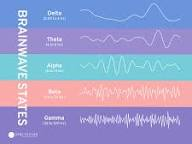“PTSD isn’t what’s wrong with you, it’s what happened to you.”
-Unknown
Summary:
Binaural beats are an auditory phenomenon that involves listening to two different tones with slightly different frequencies, one in each ear. The brain perceives a third tone that is the difference between the two frequencies, which is known as the binaural beat. This can cause a synchronization of brain waves and induce a state of relaxation, reduce stress levels, promote better sleep, improve focus and concentration, and alleviate symptoms of anxiety and depression. Binaural beats can be easily accessed through headphones or speakers and are used as a natural and non-invasive method of promoting wellness and personal development.
Detail:
• Binaural beats are said to synchronize the brain waves to induce relaxation and reduce stress levels.
• They may help in improving focus and concentration, making it useful for studying or working.
• Some people claim that they can promote better sleep and alleviate insomnia.
• Binaural beats may have pain-relieving effects and help in reducing symptoms of anxiety and depression.
• They can be used as a complementary therapy for some conditions such as ADHD, PTSD, and chronic pain.
• Binaural beats are accessible and easy to use, as they can be listened to through headphones or speakers.
• They offer a non-invasive and natural method of promoting wellness, without the need for medication or invasive procedures.
• They can be used anytime, anywhere, making it a convenient tool for self-care and personal development.
Skill:
How & Where to listen to Binural Beats: –
- Identify your mood: Determine the mood you are in and what you want to achieve, such as relaxation, focus, or sleep.
- Choose the frequency range: Binaural beats are available in different frequency ranges, and each range is associated with a particular mood or state of mind. For example, lower frequencies (Delta and Theta waves) are associated with relaxation and sleep, while higher frequencies (Alpha and Beta waves) are associated with focus and concentration.
- Listen to samples: Listen to samples of binaural beats within your chosen frequency range and select the one that resonates with you the most. Many platforms offer previews or samples of binaural beats before you purchase or listen to the full version.
- Experiment with different types: Try out different types of binaural beats, such as those with nature sounds or instrumental music, to find what works best for you.
- Pay attention to how you feel: As you listen to the binaural beats, pay attention to how you feel and adjust accordingly. If you feel restless, try a different frequency range or type of binaural beat until you find what works best for you.
- YouTube: There are numerous videos on YouTube that offer binaural beats in different frequencies, durations, and types.
- Mobile Apps: Many mobile apps offer binaural beats and other forms of meditation and relaxation techniques such as Calm, Headspace, and Insight Timer.
- Websites: There are several websites that offer binaural beats for free or for a fee, such as Gaia, Brain.fm, and BinauralBeatsMeditation.com.
- Music Streaming Services: Some music streaming services like Spotify offer playlists that include binaural beats.
- Binaural Beats Generators: There are online generators that allow you to create your own binaural beats by adjusting the frequency and duration of the tones, such as MyNoise and Binaural Beats Online.
Action:
Consume
Difficulty:
Easy
Speed:
Medium
Other Compatible Coping Skills
How many stars would you award this coping skill?

